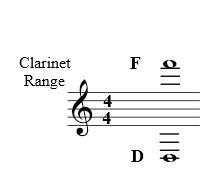Now for some essential details to remember when trying to emulate the sound of a clarinet on your Yamaha AR.
The range of the Bb Clarinet, when it sounds that is, not how it looks in the music, is from the D below middle C up to F above the third ledger line above the treble clef, like this:

That means that when playing a clarinet with 8’ settings, you should not play either the lowest 2 notes, or more importantly the top 7 notes on your Upper Keyboard, to be authentic.
A good clarinetist will use vibrato when playing longer notes or playing slowly, by controlling their diaphragm and sending quick pulses of air through the instrument.
Once a clarinet player stops blowing the sound stops immediately, so never use Sustain on your Organ with a clarinet Voice, because it is impossible to do so on the real instrument. Yamaha help us here in that they made sure that with a Voice on our
Lead, on the Upper Keyboard,
you cannot choose sustain, anyway!
Don’t forget that a
Clarinet can only play one note at a time.
So to be authentic, make sure you do the same, and only play single note melodies. Therefore, select your clarinet voice from the Lead Voice section.
Clarinet players
start their notes in one of two ways.
First – by
tonguing the note Second – by
slurring the noteIf they tongue the note they effectively use their tongue to say ‘dah’ as they play, and that gives the note a definite start.
However, slurring means that they don’t use their tongue, not even from one note to the next. This makes the notes smooth. So here again you can choose to emulate them, by either attacking the note, with a definition from the previous note, or by playing the notes smoothly, almost running your fingers together on the keys.
By
controlling the air flow, a clarinetist can increase the
volume on one note, or a series of them. Of all the woodwind instruments, the clarinet has the greatest variation in this area, and achieves the greatest range between loud and soft.
You can replicate this either with your expression pedal, or clever use of your
touch sensitive settings.
We have on our Yamaha AR organs, both
Initial Touch and
After Touch.
Initial Touch is affected by how hard you strike the note, whereas After Touch reacts to how hard you press down on the note once you have struck it. You can combine these two to create the same effect that a Clarinetist can make. The difference is they use their tongue, breath and diaphragm, while you use just your fingers.
You can view what your Yamaha AR manual says about the Touch Tone feature by clicking this link, to open it in a new window:
http://www.ar-group.org/smforum/index.php?topic=3193.0Mentioning
Breath, don’t forget a Clarinetist has to breathe regularly. So when you use that voice on your AR, you should also ‘take breaths’.
One way of perfecting this is to take a breath as you begin to play a phrase and as you let it out, see how long you can maintain it before you have to take another. This should help you to lift your fingers from the keys at appropriate points, especially at the end of phrases, in order to allow the Clarinetist to take a breath’.
I trust this will help you to
think (and play) like a true Clarinetist.
Peter